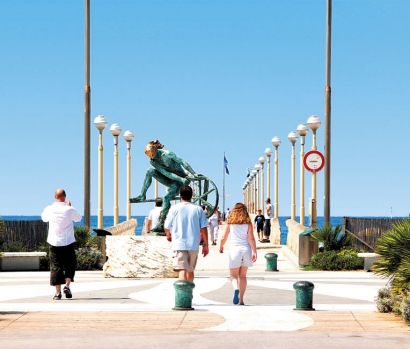Italy's elegant Forte dei Marmi still lures the jet set
 Forte dei Marmi - At the turn of the century, the Tuscan coastal town of Forte dei Marmi became hugely popular with artists, aristocrats and intellectuals from all over Europe.
Forte dei Marmi - At the turn of the century, the Tuscan coastal town of Forte dei Marmi became hugely popular with artists, aristocrats and intellectuals from all over Europe.
Nowadays, the "beautiful people" still flock here to spend their holidays among the pine trees. In downtown Forte dei Marmi, the fashionable Café Versilia on the Piazza Garibaldi was a popular haunt for famous cultural names such as English writer Aldous Huxley, Italian poet Gabriele d'Annunzio or German author Thomas Mann. The latter allegedly based the character of the sorcerer, Cipolla, in his 1929 novella Mario and Magician on someone he met on the premises.
The tranquil resort on the attractive Versilia coast continues to lure an immaculately-clad jet set and remains a byword for elegance. Guests sip a glass of prosecco under the linen sunshades which line the far-reaching golden sands.
The beach bars are abuzz in the summer months, competing for attention alongside an extensive range of water sport activities and an ambitious cultural programme. The main beach stretches five kilometres between the rivulets of Fiumetto in the south and Cinquale to the north.
The name Forte dei Marmi translates as The Fortress of the Marble and the first settlers in this swampy area were dealers in the glossy white rock whose use in architecture goes back to classical Greek times.
In the 16th century, a certain Michelangelo Buonarotti, the Renaissance all-round genius commonly known only by his first name, was commissioned by Pope Leopold X. to draw up plans for the road to connect the marble quarries at Massa and Carrara in Apennine Mountains with the coast.
The artist set to work and both the road and a 300-metre along the pier were built so that the prized stone could be hauled aboard sailing ships. Today both locals and tourists gather at the spot to admire the spectacular sunsets.
A century later, the resort began to attract fishermen, farmers and quarry workers and it was in 1788 under the aegis of Grand Duke Leopold I that the town acquired its most notable landmark, the red brick fort in the main square "Il Fortino."
Tourism in Forte dei Marmi only began to boom after World War II when wealthy Italian industrialists chose it as a summer retreat. Today the "Fortino" is home to the Museum for Satire and Caricature and visitors can admire exhibits dating back to antiquity as well as contemporary works. For those who want more there is even a specialised multimedia archive on the topic.
This town of around 8,500 residents - known to its admirers as "Forte" - offers an unusually rich tableau of cultural activities. There are numerous galleries and the town is a useful springboard for visits throughout Tuscany. Lucca, Florenz and Pisa are only a short ride away by local train.
There are plenty of chic cafes to visit in the central Forti and the town offers a wide range of hotel accommodation to suit all budgets. Four-star hotels line the promenade behind a fringe of oleander and palm trees while the more reasonably-priced establishments are generally found in the centre or on side streets.
The nearby Apennines offers all manner of sporting pursuits such as hiking and climbing tours while at the seaside windsurfers and kite surfers will find plenty to keep them occupied. A fine way of seeing Forti is from the saddle of a bicycle since in contrast to most places in Italy, the town has an extensive network of cycle paths. (dpa)